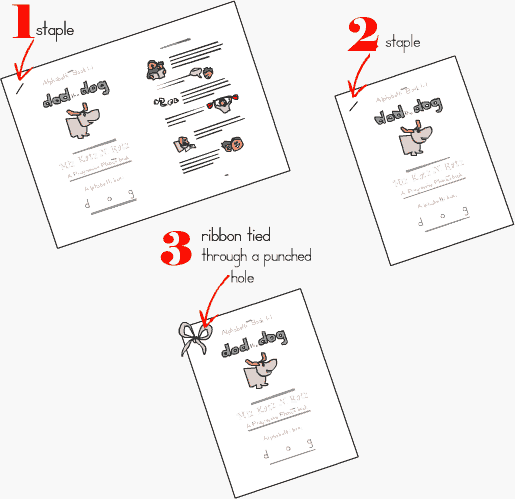
No, at this time we do not have printed copies of the books, only the downloadable e-books.
We would love to release printed copies of the books, but this is not feasible at this time – we are only on version two of the books, and it would be foolish to print our many books (and their matching worksheets) before version three at least.
Therefore, we will only print the books when we are sure that any and all errors are out, and that the books follow the best sequence and learning curve possible. You can help by reporting any errors you see to the Bugs and Errors Forum.

Good news! We are back in production on the Alphabetti books. We just cleaned up and expanded the Dod and Bob series (first series), and are in the middle of cleaning up and expanding the Sid and Sis series (series two). The next three series are also well on their way.
A new Alphabetti book will be released each week.

Alphabetti books: Ages 3 - 6. These books are good for children just learning the alphabet, or as remedial education for children who struggle with letter recognition and differentiation.
Beginner Phonics Books: Ages 4 - 7. These books are good for children who already know their alphabet. The books develop fluency in reading small, short-vowel words.
Intermediate Phonics Books: Ages 6 - 8. These books are good for children who are comfortable reading short-vowel words. Some younger children can read these books, but proceed with caution.
Advanced Phonics Books: Ages 7 - 10. We don’t recommend these books for younger children unless they are gifted readers.
The books are also used in adult education (remedial and English as a Second Language), as well as in remedial education for middle and high school children.
 The important thing is to proceed at a pace that suits the child/student. Some children/students need a LOT of repetition. Some children/students gobble it up (eat it up) and are ready to move on quickly.
The important thing is to proceed at a pace that suits the child/student. Some children/students need a LOT of repetition. Some children/students gobble it up (eat it up) and are ready to move on quickly.

The Progressive Phonics program was developed around two bodies of research:
 The Dolch Sight-Word list, which was researched and developed by Edward Dolch, PhD. However, rather than presenting the "Dolch words" as lists of sight-words to be memorized, we took on the challenge of presenting the words phonetically and "anti-phonetically" (rule-breakers). For more information, please see our article on "Dolch words."
The Dolch Sight-Word list, which was researched and developed by Edward Dolch, PhD. However, rather than presenting the "Dolch words" as lists of sight-words to be memorized, we took on the challenge of presenting the words phonetically and "anti-phonetically" (rule-breakers). For more information, please see our article on "Dolch words."
 Our program also complies with the recommendations of the U.S. National Institute for Literacy, especially in regards to guided oral reading (reading out loud with feedback). Please see our article on reading aloud. The U.S. National Institute for Literacy also found compelling evidence linking reading progress with handwriting instruction, which is why we produce matching handwriting worksheets and activity sheets for each of our books. Please see our article on handwriting.
Our program also complies with the recommendations of the U.S. National Institute for Literacy, especially in regards to guided oral reading (reading out loud with feedback). Please see our article on reading aloud. The U.S. National Institute for Literacy also found compelling evidence linking reading progress with handwriting instruction, which is why we produce matching handwriting worksheets and activity sheets for each of our books. Please see our article on handwriting.
For more information on the U.S. National Institute for Literacy and its study, please follow this link: National Reading Panel Study.


A rather hairy creature who is fond of cheese, catnip and exercising on her treadmill. She sold her first cartoon at age seven, and hasn’t stopped drooling... uh, drawing since.
(Translation: A writer and illustrator who enjoys linguistic challenges and working with children.)

We discontinued the old fonts because there was more demand for print-style fonts. (The old fonts were pre-cursive fonts.)
If it is important to you to have the pre-cursive fonts, please post a thread/request in the "Feature Requests" forum.

Soon.
We just finished the "renovation" of the Intermediate Series, and will start the "renovations" for the Advanced series in July 2009. These revisions will take about two months.
In the meantime, please use the old versions of the Advanced books.

Most people staple the books in the upper left corner (see image #1 below).
Some people cut the pages in half and staple them together (see image #2 below) -- this requires a heavy-duty stapler that can staple 20 or more pages.
If you want to cut the pages in half and don't have a heavy-duty stapler, you can punch a hole in the upper left corner and tie the pages together with a ribbon (see image #3 below).
